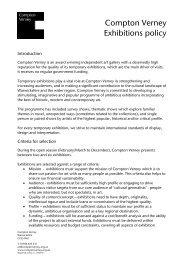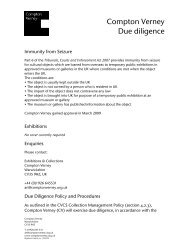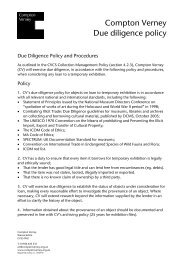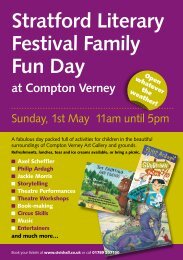Read the gallery guide - Compton Verney
Read the gallery guide - Compton Verney
Read the gallery guide - Compton Verney
You also want an ePaper? Increase the reach of your titles
YUMPU automatically turns print PDFs into web optimized ePapers that Google loves.
1. Marcus Gheeraerts <strong>the</strong> Younger<br />
(1561/2-1636), Flemish: A Boy Aged Two.<br />
Oil on panel, inscribed and dated<br />
Aetatis suae 2 / Anº 1608. 114.3 x 85.7 cm<br />
The child in this portrait wears a bodice and<br />
skirt over a farthingale frame. This was <strong>the</strong><br />
fashion for dressing boys until <strong>the</strong>y were<br />
‘breeched’ (dressed in breeches or trousers) at<br />
<strong>the</strong> age of five or six. In his left hand he holds a bunch of flowers<br />
and a string attached to a robin. The flowers are pansies and<br />
signified innocence and transience, whilst birds are thought to<br />
symbolise <strong>the</strong> human soul flying away at <strong>the</strong> moment of death.<br />
2. Jacopo da Trezzo<br />
(about 1514-89), Italian: Queen Mary<br />
Tudor. Silver, 1554. Diam: 6.8 cm<br />
After Jacopo da Trezzo: King Philip II<br />
of Spain, Silver electrotype, 1800s.<br />
Diam: 6.8 cm<br />
Jacopo da Trezzo was a Milanese<br />
goldsmith who specialised in<br />
elaborately-worked, cast medals, and<br />
worked for King Philip II of Spain. Queen Mary I of England<br />
reigned from 1553 until 1558, and she and Philip were married<br />
in 1554. The reverse of <strong>the</strong> Mary I medal suggests that England<br />
is a peaceful country under her rule, showing <strong>the</strong> figure of Peace<br />
burning armour and banishing storm clouds. This medal is listed<br />
in <strong>the</strong> inventory of <strong>the</strong> Chigi family of Rome, dated 22 March 1674.
















